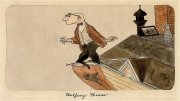At the Start of freshman year, my entry way neighbors and I were summoned to a meeting on diversity. On a Saturday morning, we filed into a room in Boylston Hall expecting another in the endless series of mandatory Freshman Week meetings. The discussion began slowly but became more ardent when the question of how to build diverse communities was raised. At the conclusion of the meeting, we agreed that diversity cannot be imposed and must be accompanied by goodwill.
Most students were content to let the debate rest there until last spring, when Fred Jewett, then dean of the College, decided to fully randomize House assignments for rising sophomores, starting with the class of 1999. This unleashed an acrimonious debate that engulfed the last days of his tenure. Much of the subsequent protest originated, surprisingly, not with freshmen but with upperclassmen unaffected by the change. This revealed the deeper cause of resentment: a feeling among students that a more organic diversity had taken root among Harvard's student communities and that this was not adequately appreciated.
When President Abbott Lawrence Lowell announced the House system in 1928, he had two purposes in mind: to help students build communities where they would feel less overwhelmed by the size and impersonality of Harvard, and to ensure that those communities were representative cross-sections of the College. But diversity was then defined entirely in terms of differences among white male students, most of them from New England. The recognized categories were economic background, regional origin, fields of concentration, secondary education (private versus public schools), and class rank.
But the social changes of the late 60s and early 70s brought in more ethnic and racial minorities, and residential segregation between Harvard and Radcliffe ended in 1971. Diversity came increasingly to mean race, ethnicity, gender, and sexual orientation. With this broadened idea of diversity, the dual goals of making students feel at home and making each House a microcosm of the College came increasingly into conflict. Also in those turbulent years, the administration appeased students by eliminating the masters' prerogative to select applicants from among rising sophomores, replacing it with a process in which students, collectively entering a lottery in self-selected "rooming blocks," were assigned to their highest possible preference.
By the mid-8os, many masters were beginning to complain of "skewing" in some of the Houses. "It was first really clear among the athletes," says John E. Dowling, master of Leverett House and a staunch advocate of randomization. "But as we looked, we began to realize that there was distortion in other ways. One House had a great predominance of natural-science concentrators. Another had most of the gay and lesbian students, and one had an excess of students from prep schools. There have been Houses which had large black populations relative to the College population." As a result, the College began to limit student choice, starting in the late 80s with the "non-ordered" system in which blocks of students were allowed to choose but not rank four Houses, to one of which they were assigned randomly. Finally Jewett (who graduated from the College in 1957) decided student blocking groups would be assigned to Houses in a completely random manner.
Harry Lewis, now dean of the College, coauthored the report advocating the fully randomized assignment system. Lewis (who graduated in 1968) called the decision "an educational matter: under what system would students gain the most from their Harvard experience?" He cited as a secondary consideration "discontent with the seemingly endless strategizing and manipulation of the prior choice-based system."
SOME STUDENTS, however, do not buy this explanation. "The concern of the administration obviously focuses on the self-segregation that is occurring," says Jennifer Lee '98. "They have woven many euphemisms...to dress up this simple fact." The Quad Houses, for example, are especially popular among black students. "A lot of people feel disappointed that [after randomization] you won't be able to keep a black community together in terms of a physical location with a high concentration of black people," admits Kristal O'Bryant '98, president of the Harvard-Radcliffe Black Students Association (HRBSA). "When you're a racial minority, you just feel more comfortable with people who look like you and listen to the same music, and have the same problems. Even during freshman year, when housing was randomized, black students still found each other in the Union and sat together. I don't think that randomization will change that dynamic."
Jean Tom '98, co-chair of the Minority Student Alliance, observes that "Many minority students, in coming to a predominantly Caucasian school, may feel somewhat alienated. In their classes or extracurricular activities, they often feel the weight of being the only black or the only Latino. They feel there are aspects of their culture or ethnicity that they cannot freely express when surrounded by their Caucasian classmates and teachers. Therefore, the only place they feel they can be fully themselves is in their dorms, where, by self-design, they are surrounded by people of the same race or ethnicity, with whom they share similar backgrounds, experiences, and tastes. I fear that randomization will lead only to a greater sense of isolation for minority students."
Some students also cite the need for communities based on common interests and tastes. "[After randomization] everyone will probably live and let live," says Rachel Kadel '98. "But having people roll their eyes and leave you alone is far different from 'That looks cool' or even 'Can I join?'"
"Randomization will erode the sense of community that comes from having chosen to live in a place and choosing to share in the culture of a House," observes Sean Peirce '98. "At Adams House, we have Drag Night every year in the dining hall. A lot of people find this bizarre, but they didn't have to choose to live here. The people who do live here really enjoy it. But how long can this tradition last if people are being randomized into Adams House who find the whole thing silly or bizarre?"
Robert Kiely, master of Adams House, remains one of the most vocal opponents of the new policy. "The administration is fooling itself if it thinks that it can promote true diversity with randomization," he says. "Integration happens when students want it to happen and are willing to make it work. I don't feel that you can force it."
The purpose of the Houses, according to Kiely, is to foster communities that are supportive of students. "Many years ago, sexual orientation was not even considered to be a form of diversity," he notes. "Who knows what invisible minority groups are still unrecognized today? Many gay and lesbian students have come to me over the years and said if it hadn't been for Adams House, they would not have survived at Harvard. We don't always know the network of support that exists in the Houses."
Other masters nevertheless have felt that the overriding mission of the House system is to educate students on diversity, and have been determined to end the pattern of self-segregation they observe. "There is no doubt that virtually all of our students come from much more homogeneous backgrounds than they have here, and there is no doubt that many will return to much more homogeneous places," Dowling notes. "Here is the one opportunity we have really to experience students from all over the world, from all walks of life, all religions, all viewpoints, and to take advantage of that as much as possible."
Kiely calls this a "noble ideal" that can be realized only if students are persuaded to support it and if it occurs spontaneously among students. "Why should an administration that consists predominantly of white males tell minority students where to live and what diversity means?" he asks. "It's a more philosophical than mathematical question. The administration's view of diversity is a crude measure, but true diversity can only happen among students in much more subtle ways."
"The decision has already been made. Why don't we give it a try?" Dowling urges. "If four or five years from now, the House masters decide it is not working out, we can review it."
OUR UNDERGRADUATE community unavoidably inherits the tensions, mistrust, and divisiveness of the society from which Harvard draws its students; this must be kept in mind before pronouncing randomization a solution. Nevertheless, Harvard students are on the whole eager and skillful bridge-builders. And, in the end, whether we achieve true diversity will depend less on what administrators decide in University Hall than on what students themselves choose to do in the myriad encounters in classrooms, dining halls, entryways, and Houses that make up the life of the College.
During freshman year, I read an article in a student publication in which an acquaintance of mine, who is Latino, said he avoided sitting down next to whites in the Union because he didn't know who might be racist. I can understand his feelings since, as an Asian, I came to Harvard with my own fears of how I would be received. But I cannot agree with his conclusion that, to avoid risk, we may leave mistrust unchallenged. During Freshman Week, a neighbor from across the hallway stopped by to talk. I am glad that he, a Caucasian, was not deterred from approaching an Asian, since otherwise I might never have met my present roommate and best friend.








